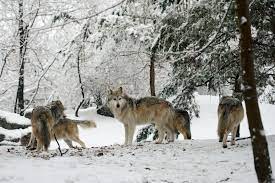There are currently no know Mexican wolves in Mexico, with the last 5 having been captured in 1980 to create a breeding program. It is possible that a few survived and have not been seen (there is a great deal of wilderness in Mexico), but from what is known they are none left in Mexico.

There are plans to reintroduce them in the near future. Mexican grey wolves once ranged widely from central Mexico throughout the southwestern U.S. including Utah, Colorado and Texas.
They have been reintroduced to south-eastern Arizona and southwestern New Mexico so far. In 2019 a thorough survey found there were 163 wolves in 42 wolf packs. The initial release occurred in 1998.
When a species gets this close to extinction it becomes quite a hands on process to save it. This means that there is a great deal of moving Mexican wolves from captivity (there are about 350 in captivity) from there into places in the wild. The simplest process is to take wolf cubs from their mother shortly after they are born, and introduce them to “foster mothers” in the wild, who will usually bring them up as their own. This adds new genes to the wild pack, allowing them to gain genetic health.
Conservationists have sued the USA government, because they believe that they have been set up to fail.
Ranchers argue that wolves ruin rural livelihoods, and apart from the reluctance to give them space, wolves die after car collisions as well as from farmers defending their livestock. – with almost as many roam free, that have been killed from these reasons.
Adults have stopped being introduced after successful arguments from ranchers that adult wolf reintroductions are more likely to be dangerous to humans – as a result this method of foster mothers is the current only way to bolster the wild population.
While Mexican wolves are smaller and browner than others in the USA, it is likely that before human settlement, the two populations would have interbred along the divide.
There are issues with the level of genetic variation – all wild and captive Mexican wolves are descended from 7 (the initial 5 plus 2 that were found in zoos to be genetically Mexican), and all the 200 wild Mexican wolves are thought to be genetically similar as siblings.
The foster pups are the only way to deal with this. The agency working with the wolves has set a target of 22 foster pups surviving in the wild to breeding age, and so far 13 have reached this milestone.
It will be some time before the wild Mexican wolves can be left to continue without human interruption. Never-the-less this species seems to be doing well at the moment. Time will tell if it is going to recover to previous levels.
